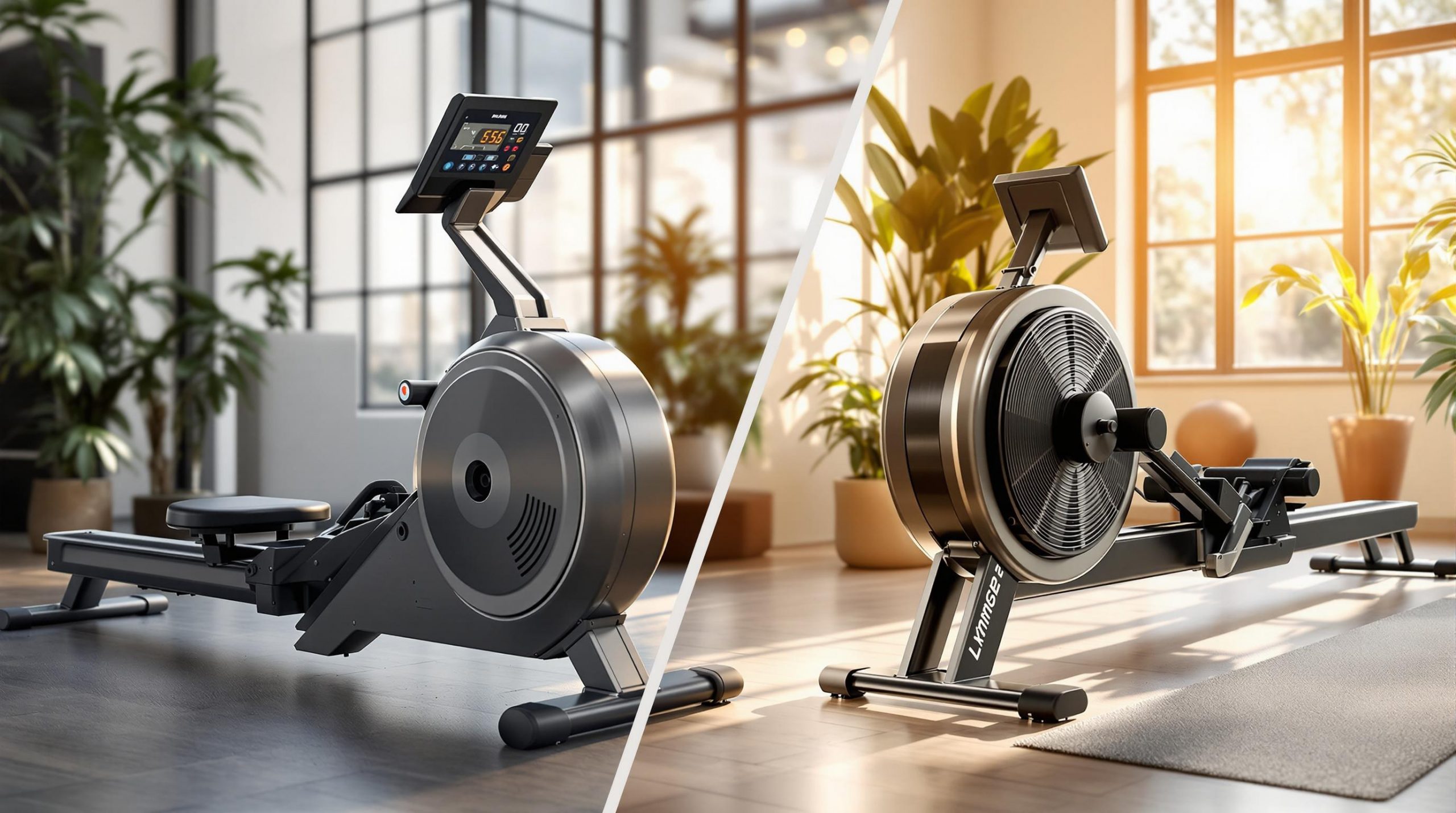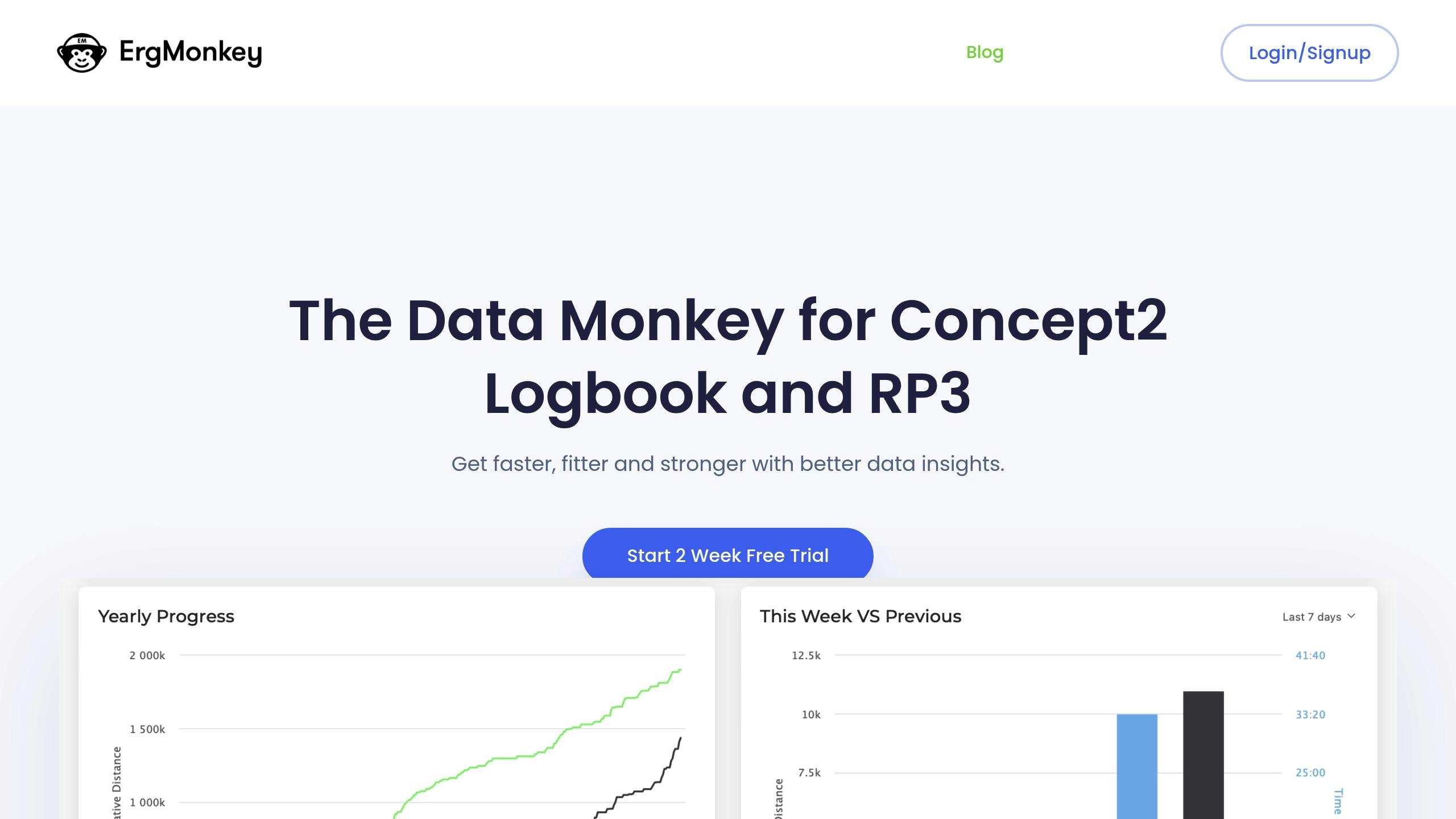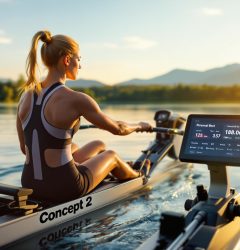01 Mar

When choosing between magnetic and air resistance rowing machines, the key differences come down to energy use, workout style, and maintenance. Magnetic rowers rely on external power for steady resistance, making them quiet and low-maintenance. Air rowers, on the other hand, are self-powered, dynamically adjusting resistance based on your effort, but they can be noisier and require more upkeep. Here’s a quick comparison:
| Feature | Magnetic Resistance | Air Resistance |
|---|---|---|
| Power Source | Requires external power | Self-powered |
| Resistance Type | Fixed, steady resistance | Adjusts with effort |
| Noise Level (dB) | 51 | 73 |
| Maintenance | Low | Needs regular cleaning |
| Best For | Quiet, steady-state cardio | Intense, dynamic workouts |
Magnetic rowers are ideal for quiet, low-maintenance use, while air rowers provide a dynamic, water-like experience suited for high-intensity training. Your choice depends on your workout goals, noise tolerance, and maintenance preferences.
Hydraulic vs Magnetic Rowing Machines: Ultimate Comparison
Magnetic Resistance Basics
Let’s dive into how magnetic resistance systems work and their energy needs.
How Magnets Create Resistance
Magnetic rowers rely on magnets placed near a metal flywheel to generate resistance. The closer the magnets are to the flywheel, the greater the resistance. This setup ensures that resistance remains steady, no matter how fast or slow you row.
| Resistance Aspect | Details |
|---|---|
| Resistance Source | Interaction between magnets and a metal flywheel |
| Control Method | Adjusted by moving magnets manually or electronically |
| Speed Impact | Resistance stays consistent, regardless of rowing speed |
| Noise Level | Operates quietly |
| Adjustment Range | Limited customization options |
Power Requirements
Most modern magnetic rowers need an external power source, like a standard 120V outlet or batteries. They use very little energy when idle, but unlike self-powered machines, they depend on this external power to function.
The steady resistance of these systems makes them ideal for users who want predictable workout intensity. Plus, their quiet operation and smooth performance add to the overall experience.
Air Resistance Basics
How Air Creates Resistance
A flywheel equipped with specially designed vanes moves air to create resistance. When you pull the handle, the flywheel rotates, causing the vanes to push against the air. The faster you row, the quicker the flywheel spins, moving more air and increasing resistance. This works on a squared power principle – if you double your rowing speed, you’ll need about eight times more power.
| Damper Setting | Air Flow | Resistance Level | Best For |
|---|---|---|---|
| Low (1–4) | Restricted | Lighter | Speed work, technique training |
| Medium (4–7) | Moderate | Balanced | General fitness, endurance |
| High (7–10) | Maximum | Heavier | Power training, strength building |
Now, let’s explore the energy demands of air resistance systems.
Power Requirements
Air rowers demand significant physical effort but no external power source. Data from competitive rowers highlights the intensity: during high-effort sessions, air rowers exhibit ventilation rates of 175–221 L/min, a VO₂ max of about 5,950 ml/min, and energy use around 221.5 kcal (with 70% aerobic and 30% anaerobic contribution).
To maintain consistent resistance, regular cleaning and lubrication are key to preventing debris buildup.
sbb-itb-1725142
Power Use Comparison
What Affects Power Use
Magnetic and air resistance systems differ in how they use energy. Magnetic systems rely on an external power source to adjust resistance electronically, which results in steady energy consumption.
In contrast, air resistance systems operate based on the rower’s effort. The resistance increases exponentially with rowing speed because the force is proportional to the square of the velocity.
"So, you, more than the damper setting or drag factor, create the resistive force in the handle with the velocity of your drive." – Rachel Marbaker
This connection between force and velocity is outlined in the table below.
Energy Use Data Table
Here’s a breakdown of how these systems compare:
| Characteristic | Magnetic Resistance | Air Resistance |
|---|---|---|
| Power Source | External electrical power | Self-powered (user generated) |
| Resistance Pattern | Consistent across speeds | Increases with rowing speed (squared) |
| Energy Usage | Steady energy draw | Rises significantly with intensity |
| User Energy Output | Stays relatively steady | Increases non-linearly with speed |
| Maintenance | Low due to fewer moving parts | Requires regular cleaning |
| Operating Costs | Includes electricity charges | No external power costs |
Magnetic systems are ideal for steady-state workouts, while air resistance machines are better for intensity-driven challenges. Magnetic machines need continuous electrical power, whereas air systems rely entirely on user effort but require more frequent upkeep to maintain performance. These differences are important when designing workouts and considering long-term costs.
User Results and Experience
Workout Results
The type of resistance plays a big role in how effective your workouts are. Air resistance adjusts to your effort, mimicking the feel of rowing on water – perfect for high-intensity interval training (HIIT). On the other hand, magnetic resistance provides steady resistance, making it ideal for endurance-focused workouts.
"Whatever your choice, you really can’t go wrong when it comes to choosing between magnetic, contact, and air resistance. It all comes down to personal preference and what will best serve your fitness goals!" – Sydney Bueckert, Fitness Trainer, Sunny Health and Fitness
Noise levels and maintenance needs are also important factors that shape your overall workout experience.
Sound and Upkeep
When it comes to noise, magnetic rowers are much quieter, operating at about 51 dB, compared to air rowers, which can get as loud as 73 dB.
"Magnetic rudders work without moving parts such as propellers or blades. Instead, the resistance is generated by a magnetic field that acts on an aluminum flywheel. The result: no friction, no noise, no maintenance." – Flavio, Founder, AUGLETICS
Maintenance is another area where magnetic rowers shine. They require very little upkeep, while air rowers need regular maintenance, like cleaning the chain and other moving parts.
User Experience Data
Here’s a quick breakdown of how magnetic and air resistance rowers compare on key factors:
| Aspect | Magnetic Resistance | Air Resistance |
|---|---|---|
| Noise Level (dB) | 51 | 73 |
| Workout Consistency | Steady resistance | Adjusts to effort |
| Training Style | Best for steady-state cardio and endurance | Ideal for HIIT and dynamic workouts |
| Maintenance Needs | Low maintenance | Requires regular cleaning |
| Space Requirements | Compact | Needs more room |
| Power Needs | Requires external power | Self-powered |
Magnetic rowers are a great choice for quieter, low-maintenance workouts, while air rowers deliver a more dynamic, water-like rowing experience. This makes air rowers a popular option in commercial gyms.
Performance Tracking Tools
Advanced tracking tools help you make the most of your workout data by offering deeper insights into your training.
ErgMonkey Features

Tracking your performance is key to improving on both magnetic and air rowers. ErgMonkey connects with the Concept2 Logbook and the RP3 Rowing Platform, giving you detailed insights into your workouts. It allows you to compare sessions, monitor heart rate zones, track progress, and visualize power outputs.
| Feature | Description | Benefit |
|---|---|---|
| Workout Comparison | Compare multiple sessions | Spot performance trends across resistance types |
| Heart Rate Analysis | Tracks and reports heart zones | Fine-tune workout intensity |
| Progress Tracking | Monitors long-term performance | See measurable improvements over time |
| Interactive Graphs | Offers visual data representation | Quickly grasp performance metrics |
| Power Reports | Compares energy output over time | Track changes in power and endurance |
In just two years, ErgMonkey has analyzed over 100,000 workouts, offering its users detailed insights to improve their training.
Why Data Analysis Matters
These tools turn raw data into actionable feedback, helping you row more efficiently. With insights into pace, stroke rate, heart rate zones, and overall progress, ErgMonkey empowers you to make informed adjustments to your training.
The Standard plan costs $39.99 per year and includes core features. For $49.99 per year, the Plus plan adds advanced calendar planning tools. Whether you’re analyzing energy use or adjusting to different resistance systems, these tools help you pick the rowing machine that fits your needs best.
Conclusion
Here’s a quick comparison of the key differences between magnetic and air resistance systems, focusing on their energy use and workout features:
Main Points
Air rowers and magnetic resistance systems operate differently in terms of power and workout experience. Air rowers adjust resistance automatically as your speed increases, while magnetic systems rely on preset levels and need external power.
| Feature | Air Resistance | Magnetic Resistance |
|---|---|---|
| Power Source | Self-powered | Requires external power |
| Resistance Type | Dynamic, speed-based | Fixed, preset levels |
| Price Range | $1,298–$2,898 | $1,298–$2,198 |
| Maintenance | Moderate | Lower |
| Noise Level | Higher | Lower |
This breakdown can help you decide which resistance system aligns with your needs.
Choosing Your System
Your choice depends on your goals, space, and preferences. Air resistance rowers are great for those who want a self-powered machine with resistance that naturally adapts to effort. On the other hand, magnetic rowers are ideal for quiet, low-maintenance use, especially in home or shared settings. Think about your training objectives, the noise level you can tolerate, and whether you need tracking tools like ErgMonkey to make the best decision.


